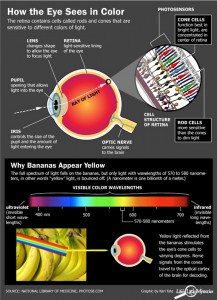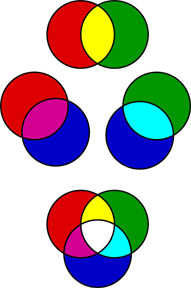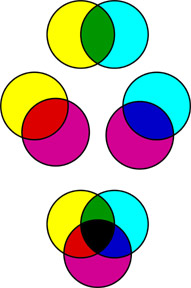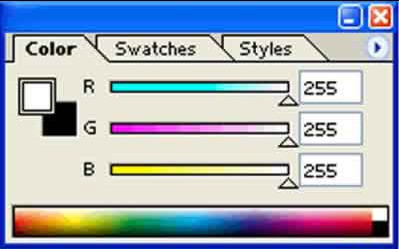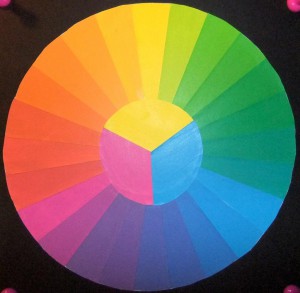November 9, 2015
Materials Needed
- Print out this Template
- mini color wheel
- primary colors gouache set – Utrecht Designer Gouache
OR
Any brand gouache primaries, including:- black
- white
- rose tyrien or primary magenta
- turquoise blue or primary cyan
- brilliant yellow or primary yellow
- flame red or primary red
- ultramarine blue or primary blue
- brushes
- ruler
- t-square
- pencils
- 9×12″ bristol.
Discussion
- Poster for Learning Communities
- Student show prep
Lecture
- What is color? And how do we see it?
- What are Primary and Secondary Colors?
- What do the CMY, RGB, and RYB color models represent?
- What is a color wheel?
Introducing Color: When light hits objects, some of the wavelengths are absorbed and some are reflected, depending on the materials in the object. The reflected wavelengths are what we perceive as the object’s color.
Visible light is made of seven wavelength groups. These are the colors you see in a rainbow: red, orange, yellow, green, blue, indigo, and violet.
Our eyes are the input channels for this light and our retina contains different types of light sensors.
- Rods: record brightness and darkness (value).
- Cones: Each one optimized to absorb a different spectrum range of visible light. (1) One set absorbs long, low-frequency wavelengths, the reds. (2) Another absorbs mid-size wavelengths, the greens. (3) The third absorbs short, high-frequency wavelengths, the blues.
Watch these short videos to understand how and why we see color:
- What is color? – Colm Kelleher
- How we see color – Colm Kelleher
- Why do we see color? Finding the Origins of Human Color Vision – PBS.org
NEW Vocabulary:
- Hue: Designates the common name of a color, determined by the specific wavelength of a ray of light and/or its position in the spectrum or color wheel.
- Primary Colors: Three colors when mixed in equal or unequal amounts can produce a variety of colors. Traditional primary colors are: Red, Yellow, Blue
- Secondary Colors: Colors created by mixing equal proportions of any two primary colors. Traditional secondary colors are: Orange, Green, Violet
RGB Additive Color Model (Light/Digital)
Humans can perceive three primary colors of light: red, green and blue. When overlaid or “added together”, they produce the secondary colors of light: yellow, cyan and magenta as in the diagram. Your digital devices all rely on RGB light to produce all the colors your see on screen.
- Red and green light together are perceived as yellow.
- Blue and green light together are perceived as cyan.
- Blue and red light together are perceived as magenta.
- All the other perceived colors can be produced by blending specific amounts of red, green and blue light.
- White light can be produced by mixing a color light and its opposite or equal amounts of red, green and blue light.
CMY Subtractive Color Model (Printing / Pigment / Real Life)
The absorption and reflection of the light that shines on an object produces the color that we see. Each color of pigment absorbs its opposite (complementary color) and the rest is reflected back at us as color. This is called “Subtraction.”
- Magenta pigment absorbs green light and reflects red and blue light, which we see as magenta.
- Yellow pigment absorbs blue light and reflects red and green light, which we see as yellow.
- Cyan pigment absorbs red light and reflects green and blue light, which we see as cyan.
The color of the light that is not “subtracted” and reaches our eyes determines what color we see. Light on a black object subtracts all colors and no light is reflected. Light on a white object does not subtract colors and reflects all the colors.
Digital Color Mixing
Color Wheel
A color wheel is an organization of hues around a circle. It is a tool used to help us understand color relationships and is traditional in the field of art and design. Sir Isaac Newton developed the first circular diagram of colors in 1666. Since then, scientists and artists have studied and designed numerous variations of this concept. 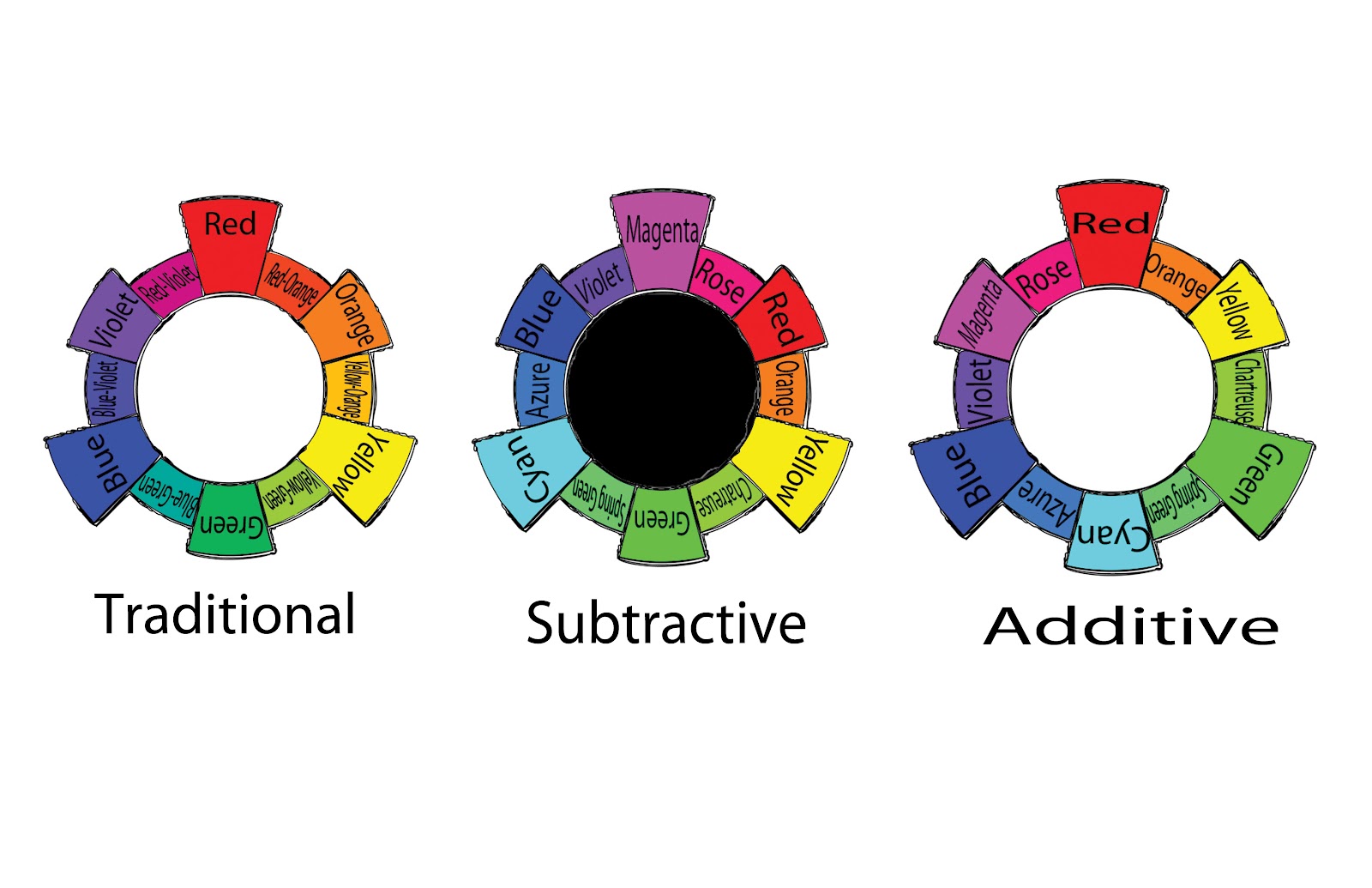
RYB Color Wheel (Traditional)
- Primary Color Triad: Red, Yellow, Blue
- Secondary Color Triad: Orange, Green, Violet
- orange (mix red + yellow)
- green (mix yellow + blue)
- violet (mix blue + red)
CMY Color Wheel (Contemporary)
- Primary Triad: Cyan, Yellow, Magenta
- Secondary Triad: Red, Green, Blue
- Green (Yellow + Cyan)
- Red (Yellow + Magenta)
- Blue (Cyan + Magenta)
- What about orange???
Lab
Color Wheel FreeStudy
Using the handouts provided, work with your partner to plan out a Traditional Color Wheel, but also incorporate CYM (Cyan, Yellow, Magenta) gouache, if you have them.
Start with the primary triad from the CYM system (Cyan, Yellow, Magenta) and create a color wheel that includes all the colors in the visible spectrum: Red, Orange, Yellow, Green, Blue, Violet.
Practice mixing and applying colors on a piece of scrap bristol first. Create colors from primary colors Cyan, Magenta, Yellow (Example: Magenta + Yellow = Red) and then secondary colors from Red, Yellow, Blue (Example: Red + Yellow = Orange) . Do NOT use pre-mixed paint hues. Try to create all colors from Cyan, Magenta, Yellow.
Once you have successfully experimented with the triad relationships (primary and secondary) from both systems, think about how the colors relate to each other.
- Think about what each color might represent: mood, emotion, object.
- Experiment with mixing each triad together, what color is produced?
- Create a numbering or labeling system to identify the different color systems.
Make sure your final color wheel composition is laid out with a clear connection to the original primaries and secondaries.
Here are some examples of interesting color wheels:
HOMEWORK
- DUE: Completed Color Wheel FreeStudy.
- Materials Needed: Same as today!
Print this page 
